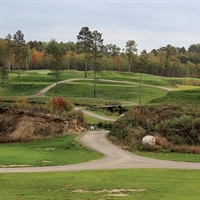Women's NCAA Division I Rankings -- April 9
April 9, 2024
Creating a golf course during a period of renewed interest in the game seems wise. But two new, short courses (conceived before we ever heard of COVID-19) take advantage of a different trend in golf: playing a quick nine holes. The Loop in Chaska and The Gravel Pit in Brainerd open this season and offer unique and inventive layouts among Minnesota courses. Still, decades after a golf boom and bust, why a new course?
“People are excited for more opportunity. It’s getting tougher to find tee times,” says Greg Kaiser, marketer and website developer for The Gravel Pit (and a Brainerd resident). “I don’t know if it’s just Covid that has driven the business, but it’s certainly growing here. There’s definitely a need for more golf.”
Short courses’ smaller footprint generate less maintenance expense than 18-hole tracks, yet they require a surrounding community of dedicated golfers to be successful—and both The Loop and The Gravel Pit check those boxes. But it may be their distinctive designs that attracts golfers short on time and long on love for the game.
The Loop
For approximately 10 years, Tim Anderson, an entrepreneur with five start-ups under his belt, worked to get The Loop built in Chaska. The idea started with former Hazeltine National GC head pro Mike Schultz and was bolstered after Anderson met former touring pro Jack Burke, Jr., at a tournament in Houston, Texas.
“He says, ‘Tim, golf has been really good to you. What are you doing to give back?’
That really put a little gas on the fire,” Anderson says. “The more I talked with people about what is needed in golf, it morphed into this project. People with disabilities are vastly underserved.”
Anderson created the non-profit Barrier Free Golf (née Learning Links) and joined forces with the City of Chaska to redesign the Chaska Par 30 course into a par 28 with access for disabled golfers. The project’s four pillars are disability access as a core design feature, building a course that is fun for everybody, environmental sustainability and financial sustainability.
“I believe we are the only one in the country who is doing all four of those things,” Anderson says. “Courses have, after the fact, been adapted to help disabled players, but I don’t think it has ever been a core design feature.”
The peripatetic Anderson, a member at North Berwick Golf Club in Scotland, met and eventually hired architect (and North Berwick native) Benjamin Warren to lead the project. Warren, 41, and a former software engineer, started in golf course architecture late, but jumped into the seat of a shaper machine for Tom Doak’s firm on Grand Saint-Emilionnais Golf Club in France, then with Gil Hanse on the Rio de Janeiro Olympic GC and more recently with Coore & Crenshaw and quickly moved up to designing his own tracks. Ultimately, he bid on The Loop because of its unique challenge.
“It’s a fascinating project,” Warren says. “I never heard of my contemporaries ever working on a course that had disability access as part of the design brief. That’s fascinating as an intellectual exercise.”
To that end, Warren assembled group discussions of disabled golfers (including blind, amputee, autistic and paraplegic golfers) and learned about their golfing experience. Among The Loop’s unique design characteristics are no bunkers, greens that stimp at 8 or 9 (so seated golfers can drive their SoloRider carts onto the putting surfaces) and fairway contours designed for riding safety. Warren brought in expert shapers from top firms to contour the course, and received some help from his new friends.
“There are elements of the design that are just straight-up standard course design,” Warren says. “But when it came to building contours suitable for the vehicles, we got our disabled buddies out there in their vehicles to ride around the site with us.”
Additionally, the slower green speeds actually worked to the architect’s benefit.
“Longer, healthier grass is more resistant to people driving vehicles, and that means you can build greens with more undulation,” Warren says. “So, as we lose the strategic interest of bunkers, you end up with more interesting greens because we are not trying to pitch the stimp to 11.”
The course loops around a central water feature (hence the name), which features grasses designed to filter environmental contaminants. But the water also levels the playing field between all golfers—because nobody likes to go into the water to hit their golf ball.
“We had a fourball of mixed abled-bodied/disabled golfers go around the course without there being one set of rules for abled-bodied golfers and another for disabled golfers. That felt to us the right thing to do,” Warren says. “The course is not designed solely for disabled golfers. It has to be fun for everyone. You are just trying to make it welcoming and friendly to disabled golfers.”
With hole names such as “Skatepark” and “Pizza Box,” both Anderson and Warren anticipate golfers of all ages and abilities coming to The Loop in August to experience the layout and check out the uniquely contoured “Minnalayas” putting course. These links are for learning and enjoying.
“There’s definitely going to be a ton of kids out there. We hope there is going to be a bunch of senior golfers, also, because the 18-hole format is not always desirable for all seniors,” Warren says. “This golf course is really suitable for golfers at the start and end of their golfing life. But folks in the middle should have fun, as well.”
The Gravel Pit
With more than 450 golf holes in the Minnesota golf mecca of Brainerd-Baxter that includes such big-name resorts as Madden’s on Gull Lake, Grand View Lodge, Breezy Point and Cragun’s Resort on Gull Lake, the obvious question becomes “why build 13 more?”
“Mark always answers that question ‘Why not?’” The Gravel Pit business owner Chuck Klecatsky says of his co-owner Mark Dvorak. “It’s a growing area; there are a lot of housing developments going on. But we wanted to offer something unique to Brainerd and complement all the great golf that’s there already. It will give people an option that is less than 4.5 hours (it will take about 2:15 to play). It’s just a different experience.”
Klecatsky is the former director of golf at Cragun’s, which is located next door to The Gravel Pit site, and he signed on to the project (and brought in his friend Dvorak and marketer Kaiser) shortly after Madden’s former pro and architect of The Classic, Scott Hoffmann, was tapped to design The Gravel Pit.
“I had my eye on that land for a while,” says Hoffmann, who operates his own course design business (scotthoffmanngolf.com). “The landowner Nathan Tuomi called saying he was considering selling the land after the 2015 storm hurt his logging income there. His youngest son, Sam, thought they should build an extreme golf driving range. When I toured the property, I suggested an extreme par 3 course. The family agreed, and we started a few weeks later.”

“The Fine Fescue grass is a low water, low chemical input grass,” Klecatsky says. “We want this to be very sustainable and good for the environment. It’s made the play firm and fast, so people will be able to play shots along the ground if they choose. The 3-way bent grass blend on the greens make for good putting surfaces.”
When Hoffmann first walked the property, it was quite chopped up, but he “could see par 3 holes everywhere.” The Tuomi’s wanted “extreme,” so that is where he took it.
“Many golf courses have a par 3 (such as the 17th island green at TPC Sawgrass) that gets your juices flowing from the very first hole,” Hoffmann says. “Our goal was to have 13 holes like that. Every time I thought I was getting too extreme, Nathan encouraged me to stay the course. Some are template holes, such as a reverse redan, double plateau, blind (modeled on the Himalayas at Prestwick) and “rolling terror” and some are unique to the property God gave us.”
The challenging track (which had a limited preview last fall) is scheduled to open mid-April.
“This is not your average par 3 course,” says Dvorak, who owns Whispering Pines GC in Annandale. “It’s kind of extreme. You’ll be able to get to the greens in one; you’re not necessarily getting down in one.”
The 13-hole course also features a 13-hole “extreme putting course” and a clubhouse with panoramic views of the rugged, North woods terrain. Klecatsky says the 13-hole routing, which had been done at Bandon Dunes (but rarely elsewhere in the U.S.), gives the clientele another exciting option to keep their golf experience rolling. Hoffmann agrees:
“It didn’t have to be exactly 13, but we definitely didn’t want 9 or 18. We wanted a golf course that was made for match play—gambler’s style—not something where you even think about your total score. Everyone feels like they can score on a par 3, so it is exciting to have that possibility of conquering a difficult hole. The Pete Dye philosophy of great risk for great reward.”

April 9, 2024

April 9, 2024
Contact Us
Have a question about the Minnesota Golf Association, your MGA membership or the contents of this website? Let us help.